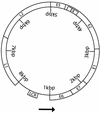Human papillomavirus and cervical cancer
- PMID: 12525422
- PMCID: PMC145302
- DOI: 10.1128/CMR.16.1.1-17.2003
Human papillomavirus and cervical cancer
Abstract
Of the many types of human papillomavirus (HPV), more than 30 infect the genital tract. The association between certain oncogenic (high-risk) strains of HPV and cervical cancer is well established. Although HPV is essential to the transformation of cervical epithelial cells, it is not sufficient, and a variety of cofactors and molecular events influence whether cervical cancer will develop. Early detection and treatment of precancerous lesions can prevent progression to cervical cancer. Identification of precancerous lesions has been primarily by cytologic screening of cervical cells. Cellular abnormalities, however, may be missed or may not be sufficiently distinct, and a portion of patients with borderline or mildly dyskaryotic cytomorphology will have higher-grade disease identified by subsequent colposcopy and biopsy. Sensitive and specific molecular techniques that detect HPV DNA and distinguish high-risk HPV types from low-risk HPV types have been introduced as an adjunct to cytology. Earlier detection of high-risk HPV types may improve triage, treatment, and follow-up in infected patients. Currently, the clearest role for HPV DNA testing is to improve diagnostic accuracy and limit unnecessary colposcopy in patients with borderline or mildly abnormal cytologic test results.
Figures




References
-
- Adam, E., Z. Berkova, Z. Daxnerova, J. Icenogle, W. C. Reeves, and R. H. Kaufman. 2000. Papillomavirus detection: demographic and behavioral characteristics influencing the identification of cervical disease. Am. J. Obstet. Gynecol. 182:257-264. - PubMed
-
- Allen, M., M. Kalantari, N. Ylitalo, B. Pettersson, B. Hagmar, L. Scheibenplug, B. Johansson, U. Petterson, and U. Gyllensten. 1996. HLA DQ-DR haplotype and susceptibility to cervical carcinoma: indications of increased risk for development of cervical carcinoma in individuals infected with HPV 18. Tissue Antigens 48:32-37. - PubMed
-
- Andersson, S., E. Rylander, B. Larsson, A. Strand, C. Silfversvard, and E. Wilander. 2001. The role of human papillomavirus in cervical adenocarcinoma carcinogenesis. Eur. J. Cancer 37:246-250. - PubMed
-
- Andrei, G., R. Snoeck, J. Piette, P. Delvenne, and E. DeClercq. 1998. Antiproliferative effects of acyclic nucleoside phosphonates on human papillomavirus (HPV)-harboring cell lines compared with HPV-negative cell lines. Oncol. Res. 10:523-531. - PubMed
-
- Apple R. J., T. M. Becker, C. M. Wheeler, and H. A. Erlich. 1995. Comparison of human leukocyte antigen DR-DQ disease associations found with cervical dysplasia and invasive cervical carcinoma. J. Natl. Cancer Inst. 87:427-436. - PubMed
Publication types
MeSH terms
Substances
LinkOut - more resources
Full Text Sources
Other Literature Sources
Medical

